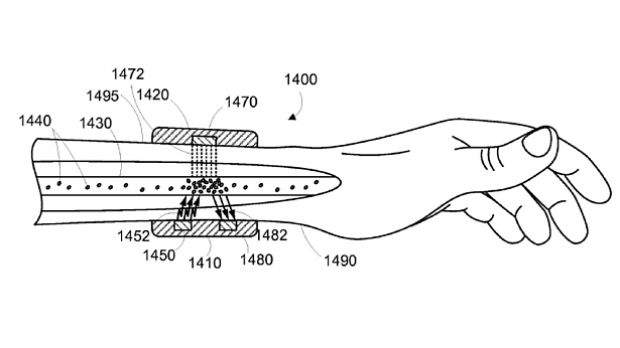Google has filed a patent application with the World Intellectual Property Organization (WIPO) for a wrist-worn device that could destroy cancer cells in the blood.
The patent application, which has the name “Nanoparticle Phoresis“, describes a wearable device that “can automatically modify or destroy one or more targets in the blood that have an adverse health effect”.
 A wearable to fight disease: An image from Google’s patent application.
A wearable to fight disease: An image from Google’s patent application.
These targets could include enzymes, hormones, proteins, cells or other molecules that, when present in the blood, may affect a medical condition or the health of the person wearing the device.
The wearable device is able to modify or destroy the cells by transmitting energy into the blood vessels. The transmitted energy could be a radio frequency pulse, a time-varying magnetic field, an acoustic pulse, an infrared or visible light signal.
This energy brings about a physical or chemical change in the targets, with the aim of reducing or eliminating adverse health effects.

Above: an example wearable device from Google’s patent application.
Google gave the example of certain proteins have been implicated as a partial cause of Parkinson’s disease. The wearable device could be used to destroy these proteins, thereby slowing the development of the disease.
“As a further example, the target could be cancer cells; by selectively targeting and then modifying or destroying the cancer cells, the spread of cancer may be diminished,” it said in its patent application.
This is not the first indication that Google is investing in cancer research. In October 2014, it emerged that Google X, the company’s research lab, was developing a pill that could detect cancer and other diseases.
The pill, which is filled with tiny iron-oxide nanoparticles that enter the bloodstream, can identity cancer tumour cells – which give off early biochemical signals when they contract the disease. It works by “painting” infected cells which travel round the body.
The nanoparticles are magnetic, so a wearable device worn on the wrist that creates a magnetic field can draw the particles – with their target cells in tow – toward it, where they can be detected and counted.
At the time, Google said that it was at least five years away from a product approved for use by doctors, but said it was working towards proactive detection rather than reactive treatment.

Above: Google’s pill “paints” infected cells.
Meanwhile, Bill Maris, head of Google’s investment arm, recently made headlines by saying that humans will live to be 500-years-old in the future, while today’s cancer treatments will soon seem “primitive”.
He also revealed that Google had hired scientists as partners in order to identify start-ups that could cure cancers.
Mr Maris said it was his duty to invest in companies that could help people to live longer: “There are plenty of people, including us, that want to invest in consumer internet, but we can do more than that,” he said.
“There are a lot of billionaires in Silicon Valley, but in the end, we are all heading to the same place. If given the choice between making a lot of money or finding a way to make people live longer, what do you choose?”
The Telegraph, London
